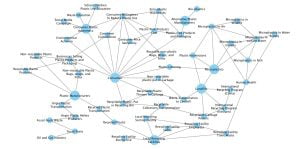
Systems Thinking
When we consider some of the world’s greatest challenges, it helps to think of them not just as complicated, but as complex. Systems thinkers often call them "wicked problems," as they have many stakeholders with interdependencies and they resist being broken down into pieces and “solved.” Instead, they require a deeper, collaborative understanding of the problem itself before any interventions can be made. Where to begin? Systems thinking offers a path forward. Let's dive in.
01. Systems Thinking Mindset
Play this game to get into a systems thinking mindset and start to see how it can open up space for new ideas and positive change.
Prepare: Gather a group together and stand in a circle shoulder to shoulder. One person will need to play timekeeper with a stopwatch. You’ll need a soft object to toss according to two rules: 1) Everyone must touch the object, and 2) They must touch it in the same sequence every time.
Engage: Practice tossing the object until everyone has caught it and the last one returns it to the first. On the next round, the timekeeper keeps time to see how fast they can do it. Remember to keep the same sequence! Keep speeding up until the system breaks down and participants drop the object. Continue until the group figures out how to redesign the system to achieve their desired goal, but always sticking to the same two original rules.
Reflect: Consider the following questions:
- Why didn’t the group think to change the system immediately? What assumptions were made? What kept the group trying to improve on their time in a poorly functioning system, given the goal of a fast time and the rules?
- Did anyone offer a solution that was ignored? Why was it ignored?
- How did the original mindset in this activity shift when the approach was changed? What did it take to shift the group’s mindset?
Act: How does this example of assumptions and limits relate to complex problems, such as disposable plastic or water scarcity? How might you apply this new mindset to tackle problems in your own community that need bold solutions?
To learn more, read Five Facts about Systems Thinking.
Full lesson plan for educators: Systems Thinking Mindset
02. What is a System?
Look at problems systemically, understand how their different parts interact, and use that knowledge to bring about positive change in the system.
Prepare: Can you think of a systemic problem you face in your daily life, such as not getting enough sleep or trying to change your diet? Can you identify some of the different parts of this system? How do they influence one another?
Engage: Look at the systemic problem of plastics illustrated in this graphic. What stands out for you as unexpected or surprising? Try to identify some interdependencies, or how one part of the system is influenced by another.
- Do you notice any interdependencies where, when one part increases or decreases, it has the same effect on the other part?
- Do you notice any where an increase or decrease in one part has the opposite effect on the other?
Reflect: Return to your personal systemic problem and try to draw connections between factors to show how they impact each other. Do they reinforce each other or balance each other out?
Act: How does your systems map help you find points for possible change? How might you apply what you’ve learned about the interaction among the parts of your problem toward solving or mitigating it?
Full lesson plan for educators: What is a System?
03. Map Your Worldview
Your Phone Is a Product of Globalization
How can analyzing the elements and interdependencies in a system help you to understand your own worldview and the impact of your decisions?
Have you ever thought about the life cycle of your cell phone? Off the top of your head, what do you think are the parts or factors involved in the system behind your phone’s production? How might knowing more about them shape your perspective or worldview about globalization in terms of your phone?
After watching the video, what stood out for you?
- Identify the elements (parts or factors in the system). Can you think of any more? Place them on sticky notes or index cards. Assign a weight (1, 2, 3) to each to reflect their importance in the system.
- Identify the interdependencies (relationships) among those elements. Move the elements accordingly and draw lines between them to show these connections. Assign a weight (1, 2, 3) to reflect the significance of these connections.
Now that you can see the elements and the interdependencies, how does this shape your worldview of the system that provides you with your phone? If you could only act on one or two areas of the system to create a shift or change in it, what elements and interdependencies would you focus on?
How does systems mapping challenge a traditional linear approach to cause-and-effect problem-solving? How will you apply this to help you make better decisions in your life and work?
Full lesson plan for educators: Map Your Worldview
04. Stakeholder Mapping
Kicking Our Plastic Habit
How do the stakeholders in an issue, and the relationships among them, shape your own role to impact change?
Stakeholders are the people or groups who influence or are influenced by an issue. Brainstorm who you think the important stakeholders are in the plastics system. Who has a stake in the plastics cycle? Who is impacted positively? Negatively?
Listen to the podcast episode “Kicking our Plastic Habit.”
- Who are the stakeholders you can deduce from listening to the episode?
- Who is responsible for creating the issue? Who is responsible for fixing it?
- Who might support a solution for the issue? Who might obstruct a solution?
How might the factors of interest (likelihood to be affected), power (over solutions) and the strength of the ties among stakeholders ultimately impact solutions?
Why is it important to determine the various categories of stakeholders, their level of power and interest and the relationships among them? How might you use what you’ve learned about stakeholders in the plastics system to shape your own role in that system?
Full lesson plan for educators: Stakeholder Mapping
05. Propose Systemic Solutions
How can the role of time, combined with what we know about the elements, the interdependencies and our own role in a system help us to envision solutions?
Think about the pollution generated from single-use plastic. How do you contribute to this? Do you actively try to reduce your plastic footprint? How?
Consider the systems map and the different-sized nodes.
- What are the most influential elements?
- What are some surprising interdependencies?
- Where are you located in the system?
What role does time play in this system? Which interdependencies might have an immediate relationship and which are more long-term? How might raising mass consumer plastic awareness impact the system over time?
How can we affect the most salient elements? What are some of the key levers that could shift this system? Propose a potential systemic intervention. How feasible is the solution?
Full lesson plan for educators: Propose Systemic Solutions
06. Map Your Social Change Role
Audiogram: Kicking our plastic habit
How can understanding our values help us to identify our unique social change role, the roles of others and how can we use this knowledge to set goals for change?
Think of a time when you wanted to change an inequity. Did you encounter obstacles? What can make moving forward difficult? Learn about Deepa Iyer’s Social Change Ecosystem Map.
Meet Vietnamese activist Hoang Thao, whose zero-plastic movement you may remember from our “Kicking Our Plastic Habit” podcast episode. After listening to the brief clip to the left, think about your own social change role in issues that matter to you.
- What are your values?
- How can you be aligned to those values in your social change work?
- What are the roles of others in your community working on similar issues?
How might you stretch your role, take bolder risks and put your values to work to bring about social change? How can you make space for others to occupy different roles?
Set at least two goals for yourself in your social change role, identifying short, medium and long-term goals.
Full lesson plan for educators: Map Your Social Change Role
07. #SolvingIt Changemakers
How can community-based changemakers, the kinds of action they take and the shifts they’ve achieved to bring equity and social justice inspire us in our own roles?
What does it mean to be a local community-based “changemaker” working to disrupt systems in the effort to bring more equity? Create a list of words or phrases.
Check out the #Solving It series on Instagram that showcases changemakers working to address some of the world’s most complex challenges.
- What are some examples of direct action, indirect action, advocacy and research that you see?
- Describe how some changemakers use multiple methods in their action.
- Share a profile that you find particularly inspiring or eye-opening.
Identify local changemakers in your own community. What kinds of actions have they taken to cause small shifts in the system?
Nominate a community member to #SolvingIt.
- Write two to three sentences summarizing how this person is working to address a complex problem.
- Why is this work critical in the path towards equity and social justice?
Full lesson plan for educators: #SolvingIt
08. Notice Shifts in Your Worldview
How can putting different lenses on our experience of systems thinking over the course of these units help us to apply this way of viewing problems to other areas of our life?
Over the course of these units on systems thinking, has thinking about complex problems as vast, tangled systems changed your perspective on the plastics problem or any other issues? How?
Return to the plastic pollution system map or one of the other complex systemic issues discussed in the previous units. Choose an issue that matters to you and consider why that is.
Consider how learning about systems thinking has impacted your worldview through three lenses.
- Mirror: What is one thing you’ve learned about yourself through this experience?
- Microscope: Do you feel your contributions to these activities had any impact on others?
- Binoculars: Where do you stand now? Did the systems maps reveal anything you did not anticipate?
How using different lenses to view issues can allow you to apply systems thinking to other areas of your life.
Full lesson plan for educators: Notice Shifts in Your Worldview









